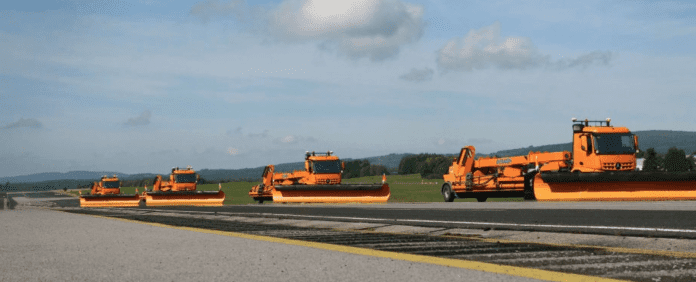German car manufacturer Daimler AG carried out a demonstration of the application of automated snow removal operations at airports based on a specific customer requirement.
The demo was carried out on the site of the former Pferdsfeld airbase, in Germany.
“We are not just talking about new technologies, we are bringing them onto the road. Step by step we are developing our very latest assistance systems even further – with a view to automated driving,” said Martin Daum, the Daimler AG Board member responsible for Daimler Trucks.
“We are currently working on the implementation of two specific use cases: Firstly automated driving in quite normal traffic on motorways. And secondly driverless operation in enclosed areas to significantly improve productivity. With this demonstration of automated snow clearance on an airfield, we are once more reinforcing our claim to technological leadership.”
Under this project, dubbed Automated Airfield Ground Maintenance (AAGM), four Mercedes-Benz Arocs tractor units demonstrate automated airfield clearing in a remote-controlled convoy. Airfield clearances are hard to predict and thus difficult to plan, especially in winter. This makes snow removal units operated with pinpoint precision by a single vehicle operator to remove snow from runways especially crucial when extreme weather strikes without warning during the winter months, and they require no additional vehicle and staff scheduling, Daimler said.
The project was established in close cooperation between Lab1886, the Daimler innovation incubator, Daimler Trucks and Fraport AG.
“As one of the first airports worldwide, we are pleased to be contributing our know-how to this innovative project. It enables us to examine autonomous control of heavy winter service equipment in the especially challenging winter conditions of an airport,” said Mathias Dudek, head of infrastructural facility management at Fraport AG. “We hope to obtain findings that will help us to plan the future deployment of equipment even more precisely and efficiently under sudden wintry conditions,” he added.
In addition to a comprehensive set of requirements on automated operating machines, Fraport also supplied the snow removal equipment for this test.
The German car maker said that the four Arocs test vehicles are equipped with the new remote truck interface (RTI) for remotely controlling vehicle functions and exchanging data. All vehicles are fully interlinked via the RTI by means of telematic systems, all operate automated and all are able to lead or follow in the vehicle convoy.
All vehicles are equipped with dual GPS tracking (DGPS) and vehicle-to-vehicle communication (V2V communication) technology, Daimler said.
The automated snow removal convoy comprises four vehicles during the test phase and can be expanded to up to 14 units. Daimler said this demo paves the way for further applications. In addition to other airports that have already signalled interest in such precision work machines for automated runway maintenance, solutions for a wide variety of applications are feasible thanks to the Mercedes-Benz remote truck interface, the manufacturer said.
“This opens up new possibilities for our customers: High-precision manoeuvring procedures of conventional trucks, remotely controlled by the driver outside the cab – for example, positioned at the rear of the vehicle with a perfect view of the manoeuvres – are possible, as is unmanned driving in mines, at container terminals or other closed-off sites”, said Martin Zeilinger, head of advanced engineering at Daimler Trucks.
The automated Arocs trucks are able to perform the following functions:
Control: engine start/stop
Control: parking brake
Vehicle lateral control: steering
Vehicle longitudinal control: engine control
Vehicle longitudinal control: service brake
Powertrain management: transmission (engage start-off gear, all gear changes, engage neutral)
Powertrain management: activation and deactivation of the differential locks
Peripherals: lights including turn indicators, rotating beacons and much more
Special functions: body control; here: control of the mounted sweeper blower
“An important component of the RTI control unit is the integrated safety concept. This means that all vehicle functions are monitored. The safety routine is executed as soon as an error occurs. In this way we can ensure that the vehicles can be stopped safely and quickly if needed, and can then simply be operated manually”, Zeilinger added.

